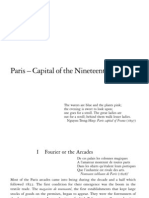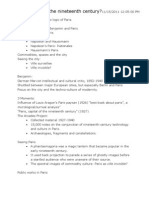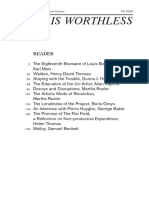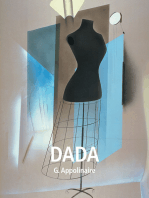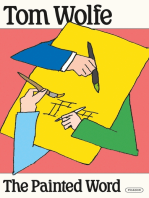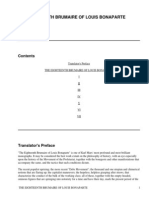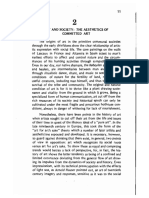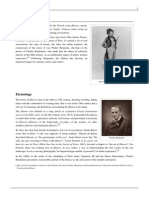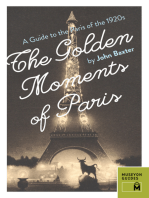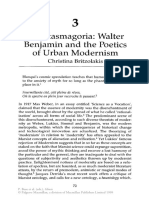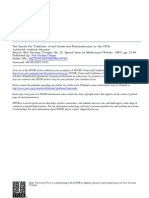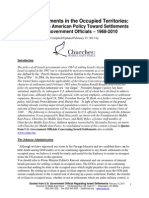Walter Benjamin - Haussmann or The Barricades
Walter Benjamin - Haussmann or The Barricades
Uploaded by
Andrea FacchettiCopyright:
Available Formats
Walter Benjamin - Haussmann or The Barricades
Walter Benjamin - Haussmann or The Barricades
Uploaded by
Andrea FacchettiOriginal Description:
Original Title
Copyright
Available Formats
Share this document
Did you find this document useful?
Is this content inappropriate?
Copyright:
Available Formats
Walter Benjamin - Haussmann or The Barricades
Walter Benjamin - Haussmann or The Barricades
Uploaded by
Andrea FacchettiCopyright:
Available Formats
VI
Haussmann or the Barricades
Jai le culte du Beau, du Bien, des grandes choses, De la belle nature inspirant le grand art, Quil enchante loreille ou charme le regard; Jai lamour du printemps en fleurs: femmes et roses. Baron Haussmann: Confession dun lion devenu vieux14 Das Blthenreich der Dekorationen, Der Reiz der Landschaft, der Architektur Und aller Szenerie-Effekt beruhen Auf dem Gesetz der Perspektive nur. Franz Bhle: Theater-Katechismus15
Haussmanns urbanistic ideal was one of views in perspective down long street-vistas. It corresponded to the tendency which was noticeable again and again during the 19th century, to ennoble technical exigencies with artistic aims. The institutions of the worldly and spiritual rule of the bourgeoisie, set in the frame of the boulevards, were to fnd their apotheosis. Before their completion, boulevards were covered over with tarpaulins, and unveiled like monuments. Haussmanns effciency ftted in well with the idealism of Louis Napoleon. The latter encouraged fnance capital. Paris experienced a great speculative boom. Speculation on the stock-exchange pushed into the background the forms of gambling that had come down from feudal society. To the phantasmagoria of space, to which the flneur was addicted, there corresponded the phantasmagoria of time, to which the gambler dedicated himself. Gambling transformed time into a narcotic. Lafargue defned gambling as a miniature reproduction of the mysteries of the market-situation. The expropriations caused by Haussmann engendered a wave of fraudulent speculation. The judgments of the Court of Cassation, which drew its inspiration from the bourgeois and Orleanist opposition, increased the fnancial risk of Haussmannization. Haussmann attempted to shore up his dictatorship and to place Paris under an emergency rgime. In 1864 he expressed his hatred for the rootless population of the great city in a speech in the Assembly. This population kept increasing as a result of his works. The increase of rents drove the proletariat into the suburbs. The Paris quartiers thereby lost their characteristic physiognomy. The red belt appeared. Haussmann gave himself the name artiste dmolisseur.16 He felt a vocation for his work and stressed the fact in his memoirs. Meanwhile, as far as the Parisians were concerned, he alienated their city from them. They no longer felt at home in it. They began to become conscious of the inhuman character of the great city. Maxime du Camps monumental work Paris owed its origin to this consciousness. The Jrmiades dun Haussmannis gave it the form of a biblical lament. The real aim of Haussmanns works was the securing of the city against civil war. He wished to make the erection of barricades in Paris impossible for all time. With the same purpose, Louis Philippe had already introduced wooden paving. Nonetheless, the barricades played a role in the February Revolution. Engels gave some thought to the technique of barricade fghting. Haussmann intended to put a stop to it in two ways. The breadth of the streets was to make the erection of barricades impossible, and new streets were to provide the shortest route between the barracks and the working-class areas. Contemporaries christened the undertaking: Lembellissement stratgique. 17
Fais voir, en djouant la ruse, O Rpublique, ces pervers Ta grande face de Mduse Au milieu de rouges clairs. Chanson douvriers vers 185018
The barricade was resurrected anew during the Commune. It was stronger and safer than ever. It extended across the great boulevards, often reached frst-storey level, and shielded the trenches situated behind it. As the Communist Manifesto ended the epoch of the professional conspirators, so did the
Commune put an end to the phantasmagoria that held sway over the freedom of the proletariat. It shattered the illusion that the task of the proletarian revolution was, hand in hand with the bourgeoisie, to complete the work of 1789. This illusion dominated the period from 1831 to 1871, from the Lyons Uprising to the Commune. The bourgeoisie had never shared this misapprehension. Its struggle against the social rights of the proletariat began right from the great revolution, and coincided with the philanthropic movement, which masked it and which experienced its most signifcant development under Napoleon III. Under him, there appeared the movements monumental work: Le Plays Ouvriers europens. Side by side with the concealed position of philanthropy, the bourgeoisie had at all times occupied the open one of the class struggle. As early as in 1831 it recognized in the Journal des Dbats: Every manufacturer lives in his factory like the plantation-owner among his slaves. The failure of the old working-class insurrections was brought about by the fact that no theory of revolution showed them the way, but on the other hand this was also the condition of the immediate power and enthusiasm with which it set about the construction of a new society. This enthusiasm, which reached its peak in the Commune, at times won over to the working class the best elements of the bourgeoisie, but in the end led it to defeat at the hands of its worst elements. Rimbaud and Courbet declared themselves for the Commune. The burning of Paris was a ftting conclusion to Haussmanns work of destruction.
My good father had been in Paris Karl Gutzkow: Letters from Paris (1842).
Balzac was the frst to speak of the ruin of the bourgeoisie. But it was surrealism which frst allowed its gaze to roam freely over it. The development of the forces of production had turned the wish-symbols of the previous century into rubble, even before the monuments which represented them had crumbled. This development during the 19th century liberated the forms of creation from art, just as in the 16 th century the sciences freed themselves from philosophy. A start was made by architecture as engineering. There followed the reproduction of Nature as photography. The creation of fantasies was preparing to become practical as commercial art. In the feuilleton, creative writing bowed to the exigencies of layout. All these products were on the point of entering the market as commodities. But they still lingered on the threshold. From this epoch spring the arcades and the interiors, the exhibition-halls and the dioramas. They are residues of a dream-world. The utilization of dream-elements in waking is the textbook example of dialectical thought. Hence dialectical thought is the organ of historical awakening. Every epoch not only dreams the next, but while dreaming impels it towards wakefulness. It bears its end within itself, and reveals itas Hegel already recognizedby a ruse. With the upheaval of the market economy, we begin to recognize the monuments of the bourgeoisie as ruins even before they have crumbled.
NOTES:
14. I worship the Beautiful, the Good, great things, beautiful nature inspiring great art, whether it enchants the ear or charms the eye; I love the spring in flower: women and roses. Baron Haussmann: Confession of a lion who has grown old 15. The wealth of decoration, the charm of the countryside, of architecture and of all scenery-effects only depend upon the law of perspective. 16. Artist in demolition. 17. Strategic beautifcation. 18. Reveal, by exposing the fraud, O Republic, to those evil men your great Medusas face amidst red lightning-flashes.
You might also like
- Forgotten Men: Timorese in Special Operations During World War IIDocument185 pagesForgotten Men: Timorese in Special Operations During World War IIErnest Patrick Chamberlain85% (13)
- Ezra Taft Benson An Enemy Hath Done This PDFDocument2 pagesEzra Taft Benson An Enemy Hath Done This PDFValerie0% (4)
- Marina Vishmidt - Speculation As A Mode of Production - Forms of Value Subjectivity in Art and Capital (2019)Document267 pagesMarina Vishmidt - Speculation As A Mode of Production - Forms of Value Subjectivity in Art and Capital (2019)Andrea FacchettiNo ratings yet
- THE CITY - Baron Haussmann and Modern ParisDocument9 pagesTHE CITY - Baron Haussmann and Modern Parisviki_delancerNo ratings yet
- Maximilien Robespierre (Voices of Revolt #1)Document96 pagesMaximilien Robespierre (Voices of Revolt #1)JoeNo ratings yet
- Thomas Crow - Modernism Mass CultureDocument47 pagesThomas Crow - Modernism Mass CultureJasmine Chohan100% (5)
- A Balthus Notebook by Guy DavenportDocument54 pagesA Balthus Notebook by Guy DavenportOlga Nikolova100% (5)
- Eisenman, Stephen - Symbolism and The Dialectics of RetreatDocument34 pagesEisenman, Stephen - Symbolism and The Dialectics of Retreatmarcusdanny100% (1)
- Impressionism (Oxford University Art Ebook)Document292 pagesImpressionism (Oxford University Art Ebook)Maite Isabel Esteiro100% (16)
- Seerat e AshrafiDocument206 pagesSeerat e AshrafiAale Rasool AhmadNo ratings yet
- Khilafat e Rashida - The Benevolent and Futuristic Model of Governance For HumanityDocument271 pagesKhilafat e Rashida - The Benevolent and Futuristic Model of Governance For HumanityBTghazwa100% (13)
- Blaszkiewicz 2020 - Listening To The Old City JM ArticleDocument35 pagesBlaszkiewicz 2020 - Listening To The Old City JM ArticleJack Blaszkiewicz100% (1)
- World CitiesDocument26 pagesWorld CitiesAnarchivistaNo ratings yet
- Romantics IgnouDocument13 pagesRomantics IgnouMohammed Asif KhanNo ratings yet
- Symbolists and DecadentsDocument96 pagesSymbolists and DecadentsapoetnNo ratings yet
- Benjamin Par IsDocument12 pagesBenjamin Par IsJoel MatthNo ratings yet
- Benjamin2Document12 pagesBenjamin2sachnish123No ratings yet
- Benjamin 1939 ExposeDocument13 pagesBenjamin 1939 ExposeAnonymous T51rWiNJNo ratings yet
- The German RomanticDocument20 pagesThe German RomanticVictor informaticoNo ratings yet
- Paris: Capital of The Nineteenth Century?Document6 pagesParis: Capital of The Nineteenth Century?Gordon ChanNo ratings yet
- FS20 What Is Worthless WEBDocument204 pagesFS20 What Is Worthless WEBrenata małeckaNo ratings yet
- LECTURE 3 MODERNISM AND THE CITY DANA AND HRISTODocument42 pagesLECTURE 3 MODERNISM AND THE CITY DANA AND HRISTONicoleta StefanacheNo ratings yet
- Content For EssayDocument12 pagesContent For EssayGia ManNo ratings yet
- Hist 211 10-5Document89 pagesHist 211 10-5Juno IantoNo ratings yet
- 18.1 - Angelo V. Suarez - Art Serves The Masses by Abolishing Itself PDFDocument6 pages18.1 - Angelo V. Suarez - Art Serves The Masses by Abolishing Itself PDFKeith Marian Gonzaga AntipasadoNo ratings yet
- Avant Garde: Au Bon Marche 1913 by Pablo Picasso.Document6 pagesAvant Garde: Au Bon Marche 1913 by Pablo Picasso.Youmna AdnanNo ratings yet
- A Quarterly Review of Contemporary "Abstract" Painting& Sculpture Editor: Myfanwy EvansDocument37 pagesA Quarterly Review of Contemporary "Abstract" Painting& Sculpture Editor: Myfanwy EvansAliciaNo ratings yet
- LULU. 22.66 77 Spreads To JK 1215, 1216 JKDocument28 pagesLULU. 22.66 77 Spreads To JK 1215, 1216 JKJohannes KneslNo ratings yet
- Some of The - Isms Post WW1: LIS470 Visual CommunicationDocument70 pagesSome of The - Isms Post WW1: LIS470 Visual CommunicationTanveer AkramNo ratings yet
- Marx, Karl & Engels, Friedrich - The Communist Manifesto (1848 Vintage, 2018)Document63 pagesMarx, Karl & Engels, Friedrich - The Communist Manifesto (1848 Vintage, 2018)vasily ratmanskyNo ratings yet
- Simmons KirchnerDocument33 pagesSimmons KirchnerCarlos De Landa AcostaNo ratings yet
- Week 1 Neoclassicism Romanticism RealismDocument17 pagesWeek 1 Neoclassicism Romanticism RealismFitz DomingoNo ratings yet
- Eighteenth Brumaire of Louis Bonaparte by Marx, Karl, 1818-1883Document61 pagesEighteenth Brumaire of Louis Bonaparte by Marx, Karl, 1818-1883Gutenberg.org100% (1)
- Realism (1840s - 1880s)Document9 pagesRealism (1840s - 1880s)Keane ChuaNo ratings yet
- Raymond Williams, When Was Modernism, NLR I 175, May June 1989Document5 pagesRaymond Williams, When Was Modernism, NLR I 175, May June 1989nev.thomas96No ratings yet
- 4 - ART & SOCIETY - Guillermo (1987)Document10 pages4 - ART & SOCIETY - Guillermo (1987)ReiNo ratings yet
- Fauvism and Expressnism The Creative Intuition PDFDocument6 pagesFauvism and Expressnism The Creative Intuition PDFCasswise ContentCreationNo ratings yet
- FlâneurDocument7 pagesFlâneurbsergiu2No ratings yet
- Decadence, Symbolism, Impressionism, Imagism, Surrealism, Futurism.Document4 pagesDecadence, Symbolism, Impressionism, Imagism, Surrealism, Futurism.Yahia RifaiNo ratings yet
- The Making of The Communist ManifestoDocument12 pagesThe Making of The Communist ManifestoChristopherGundersonNo ratings yet
- Ilarylnn: IditedDocument15 pagesIlarylnn: IditedAnderson BogéaNo ratings yet
- Art Orientation CH 19 9th Ed OnlineDocument45 pagesArt Orientation CH 19 9th Ed OnlineNguyễn Đức ÝNo ratings yet
- What Is Was ModernismDocument38 pagesWhat Is Was Modernismthantthinzar.nyiNo ratings yet
- Everything to Nothing: The Poetry of the Great War, Revolution and the Transformation of EuropeFrom EverandEverything to Nothing: The Poetry of the Great War, Revolution and the Transformation of EuropeNo ratings yet
- The Golden Moments of Paris: A Guide to the Paris of the 1920sFrom EverandThe Golden Moments of Paris: A Guide to the Paris of the 1920sRating: 3 out of 5 stars3/5 (1)
- Nicolas Bourriaud - The Radicant (2009)Document176 pagesNicolas Bourriaud - The Radicant (2009)10011854No ratings yet
- 40101527Document20 pages40101527ANIKET SHINDENo ratings yet
- Foul Perfection Thoughts On Caricature Author Accueil ArtpressDocument19 pagesFoul Perfection Thoughts On Caricature Author Accueil ArtpressNigel MatindeNo ratings yet
- 07 Britzolakis - Phantasmagoria Walter Benjamin and The Poetics of Urban ModernismDocument20 pages07 Britzolakis - Phantasmagoria Walter Benjamin and The Poetics of Urban ModernismNikos MarkoutsasNo ratings yet
- Robert Rosenblum-Cubism, From Harold Spencer (Ed.) - Readings in Art History 2Document27 pagesRobert Rosenblum-Cubism, From Harold Spencer (Ed.) - Readings in Art History 2ŽeljkaNo ratings yet
- Avangarde PostmodernismDocument19 pagesAvangarde PostmodernismHakan TopateşNo ratings yet
- Flusser Vilem 1995 Three Essays and An IntroductionDocument12 pagesFlusser Vilem 1995 Three Essays and An IntroductionAndrea FacchettiNo ratings yet
- Boetzkes - TECHNIQUES OF SURVIVAL - THE HARRISONS AND THE ENVIRONMENTAL COUNTERCULTUREDocument19 pagesBoetzkes - TECHNIQUES OF SURVIVAL - THE HARRISONS AND THE ENVIRONMENTAL COUNTERCULTUREAndrea FacchettiNo ratings yet
- Azzarito - LIBRE, COLORADO, AND THE HAND-BUILT HOMEDocument17 pagesAzzarito - LIBRE, COLORADO, AND THE HAND-BUILT HOMEAndrea FacchettiNo ratings yet
- Kindynis, T. 2014. Ripping Up The MapDocument26 pagesKindynis, T. 2014. Ripping Up The MapAndrea FacchettiNo ratings yet
- Anne Balsamo Design PDFDocument10 pagesAnne Balsamo Design PDFAndrea FacchettiNo ratings yet
- UNESCO: Media and Informational Literacy Policy and Strategy GuidelinesDocument192 pagesUNESCO: Media and Informational Literacy Policy and Strategy GuidelinesLJ's infoDOCKETNo ratings yet
- US Statements On SettlementsDocument20 pagesUS Statements On SettlementsBennet KelleyNo ratings yet
- Socially Engaged Buddhism in Historical PerspectiveDocument19 pagesSocially Engaged Buddhism in Historical PerspectiveLow Beng Kiat100% (1)
- 311/1 Paper 1: Instructions To CandidatesDocument2 pages311/1 Paper 1: Instructions To CandidatesMonda Bw'OnchwatiNo ratings yet
- Us HistoryDocument124 pagesUs Historyapi-262327064No ratings yet
- Review of KabirDocument2 pagesReview of KabirMatthew AndrewsNo ratings yet
- Student Voice Conference SVC 2019Document2 pagesStudent Voice Conference SVC 2019NetaniaLimNo ratings yet
- The Rescue of MussoliniDocument97 pagesThe Rescue of MussoliniMarko Cvarak100% (1)
- Human Nature and CONFLICTDocument8 pagesHuman Nature and CONFLICTRavesh KumarNo ratings yet
- SSCPORTAL - IN General Knowledge Notes For SSC CGL PDFDocument70 pagesSSCPORTAL - IN General Knowledge Notes For SSC CGL PDFBashart BashirNo ratings yet
- AI LegacyBooklet FINALwebDocument12 pagesAI LegacyBooklet FINALwebAmnesty International CanadaNo ratings yet
- Constitutional Law NotesDocument48 pagesConstitutional Law NotesVicki NguyenNo ratings yet
- Masterpiece Cakeshop Petition To The U.S. Supreme CourtDocument385 pagesMasterpiece Cakeshop Petition To The U.S. Supreme CourtMichael_Lee_RobertsNo ratings yet
- In Search of Ahimsa: Book ReviewsDocument2 pagesIn Search of Ahimsa: Book Reviewssivaramanlb100% (1)
- Cities - Re Imagining The Urban ReviewDocument2 pagesCities - Re Imagining The Urban ReviewlightwriterNo ratings yet
- Branch ListDocument12 pagesBranch ListarmanwarsiNo ratings yet
- A Rose For EmilyDocument4 pagesA Rose For EmilyGrace NazarenoNo ratings yet
- Rainer Traub's 1978 Article, 'Lenin and Taylor: The Fate of "Scientific Management" in The (Early) Soviet Union'.Document11 pagesRainer Traub's 1978 Article, 'Lenin and Taylor: The Fate of "Scientific Management" in The (Early) Soviet Union'.Benjamin RosenzweigNo ratings yet
- Kishanganga Hydroelectric PlantDocument3 pagesKishanganga Hydroelectric PlantAbirami BaskaranNo ratings yet
- Ui C 60 Uae Challenge Cards - Ver - 1Document4 pagesUi C 60 Uae Challenge Cards - Ver - 1Basavaraja NNo ratings yet
- CTS Punjab Police PaperDocument12 pagesCTS Punjab Police PaperDanish MuhammadNo ratings yet
- Women's StudiesDocument128 pagesWomen's Studiesgunawanasril5No ratings yet
- Lecture On 7d and CCD ApproachDocument20 pagesLecture On 7d and CCD ApproachMohsin KhanNo ratings yet
- Clarke and Ginsburg (1975) The Political Economy of HousingDocument19 pagesClarke and Ginsburg (1975) The Political Economy of HousingGong JianNo ratings yet
- FilipinoDocument7 pagesFilipinoVanessa SorianoNo ratings yet
- Life and Works of RizalDocument2 pagesLife and Works of RizalMa. Regina BaylonNo ratings yet















